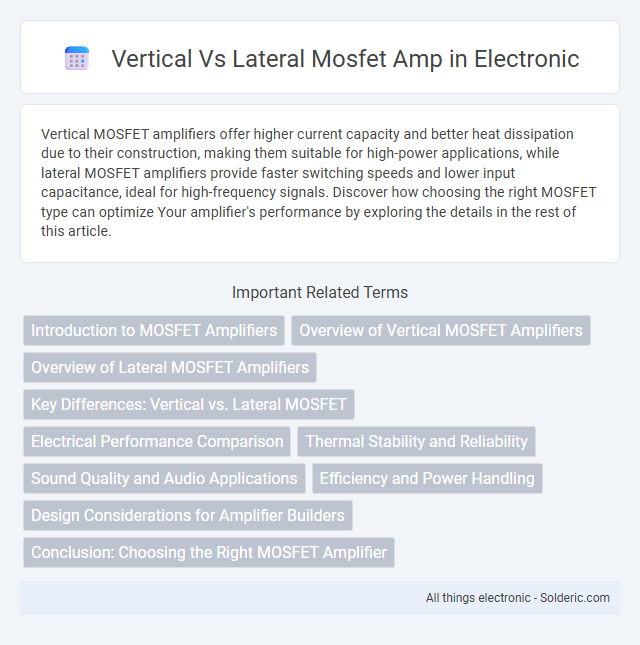Vertical MOSFET amplifiers offer higher current capacity and better heat dissipation due to their construction, making them suitable for high-power applications, while lateral MOSFET amplifiers provide faster switching speeds and lower input capacitance, ideal for high-frequency signals. Discover how choosing the right MOSFET type can optimize Your amplifier's performance by exploring the details in the rest of this article.
Comparison Table
| Feature | Vertical MOSFET Amplifier | Lateral MOSFET Amplifier |
|---|---|---|
| Structure | Current flows vertically from source to drain through substrate | Current flows laterally within the top semiconductor layer |
| Output Current Capacity | High, supports high current and power | Lower compared to vertical MOSFETs |
| Voltage Handling | Higher voltage tolerance due to vertical design | Lower voltage rating |
| Rds(on) (On-Resistance) | Lower Rds(on), better efficiency | Higher Rds(on), less efficient |
| Thermal Performance | Better heat dissipation due to vertical heat flow | Less efficient thermal management |
| Frequency Response | Typically suited for high-frequency applications | Usually limited to lower frequencies |
| Applications | Power amplifiers, high power audio amps, switching regulators | Low power analog amps, integrated circuits |
| Manufacturing Complexity | More complex, higher cost | Simple, lower manufacturing cost |
Introduction to MOSFET Amplifiers
Vertical MOSFET amplifiers feature a structure where current flows vertically from source to drain, enabling higher current capacities and better thermal management, making them ideal for high-power applications. Lateral MOSFET amplifiers, with current flowing laterally across the silicon surface, offer superior high-frequency performance and lower input capacitance, beneficial for RF and analog signal amplification. Selecting between vertical and lateral MOSFET amplifiers depends on specific design goals such as power handling, switching speed, and frequency response requirements.
Overview of Vertical MOSFET Amplifiers
Vertical MOSFET amplifiers utilize a vertical structure allowing current to flow perpendicular to the wafer surface, resulting in higher current handling capabilities and improved thermal performance compared to lateral types. Their design enables lower on-resistance and enhanced power efficiency, making them ideal for high-power, high-frequency applications. Your choice of a vertical MOSFET amplifier ensures robust operation in demanding environments with superior heat dissipation.
Overview of Lateral MOSFET Amplifiers
Lateral MOSFET amplifiers feature transistors with channels oriented parallel to the semiconductor surface, offering improved integration in CMOS processes and lower input capacitance, which benefits high-frequency applications. Their planar structure allows for easier fabrication of matched devices, making them preferable in low-noise and low-voltage analog circuits. You can expect lateral MOSFET amplifiers to excel in precision and compactness compared to vertical MOSFET designs.
Key Differences: Vertical vs. Lateral MOSFET
Vertical MOSFETs feature a current flow perpendicular to the chip surface, enabling higher current capacity and lower on-resistance, making them ideal for power amplification in high-frequency audio amplifiers. Lateral MOSFETs have current flow parallel to the chip surface, offering better linearity and lower distortion, which benefits precision audio signal amplification with less harmonic distortion. The structural design differences impact thermal performance, with vertical MOSFETs generally exhibiting superior heat dissipation suitable for high-power applications, while lateral types excel in low-noise and high-fidelity audio circuits.
Electrical Performance Comparison
Vertical MOSFET amplifiers exhibit higher current handling capabilities and lower on-resistance due to their vertical current flow path, resulting in improved power efficiency and thermal management. Lateral MOSFET amplifiers, with their planar structure, offer faster switching speeds and lower parasitic capacitances, enhancing high-frequency performance. Electrical performance comparison reveals that vertical MOSFETs are better suited for high-power applications, while lateral MOSFETs excel in high-speed, low-voltage signal amplification.
Thermal Stability and Reliability
Vertical MOSFET amplifiers offer superior thermal stability due to their robust heat dissipation capabilities, as the current flows vertically through a larger substrate area, reducing hotspots. Lateral MOSFET amplifiers, while easier to integrate on a chip, tend to have higher thermal resistance, leading to increased susceptibility to thermal runaway and reduced reliability over extended use. For your applications prioritizing durability, vertical MOSFET amps are generally more reliable under high power and temperature conditions.
Sound Quality and Audio Applications
Vertical MOSFET amplifiers typically offer higher current capacity and better heat dissipation, resulting in robust sound quality with lower distortion and improved dynamic range, ideal for high-power audio systems. Lateral MOSFET amplifiers excel in precision and linearity at lower power levels, delivering cleaner signal reproduction with minimal noise, making them suitable for sensitive audio applications such as preamplifiers and headphone amplifiers. The choice between vertical and lateral MOSFETs depends on the specific audio application requirements, balancing power handling and sonic fidelity.
Efficiency and Power Handling
Vertical MOSFET amplifiers offer superior power handling capabilities due to their robust structure and efficient heat dissipation, making them ideal for high-power applications. Lateral MOSFET amplifiers typically provide faster switching speeds and better efficiency at lower power levels, benefiting compact and low-power designs. Your choice should consider the trade-off between power capacity and efficiency needs in your specific application to optimize performance.
Design Considerations for Amplifier Builders
Vertical MOSFET amplifiers offer higher current handling and better thermal dissipation due to their perpendicular current flow and substrate connection, making them ideal for high-power audio applications. Lateral MOSFET amplifiers provide superior linearity and lower distortion due to their planar structure and shorter signal paths, favoring low-power, high-fidelity designs. Amplifier builders must balance thermal management, distortion levels, and power requirements when selecting between vertical and lateral MOSFET topologies to optimize performance.
Conclusion: Choosing the Right MOSFET Amplifier
Vertical MOSFET amplifiers offer higher power handling and better thermal performance due to their structure, making them ideal for high-current applications. Lateral MOSFET amplifiers provide faster switching speeds and lower gate charge, which benefits high-frequency and low-voltage circuits. Selecting the right MOSFET amplifier depends on the specific application requirements such as power levels, switching speed, and thermal management constraints.
vertical vs lateral mosfet amp Infographic

 solderic.com
solderic.com